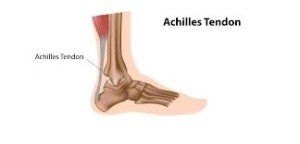What Are Tendons?
A tendon is a dense strong band of tissue that joins muscle to bone, with the tendon essentially anchoring the muscle to the bone as it moves the implicated joint. Essentially, the muscle continues to run into & become the tendon, allowing for more smooth transfer of load between the tissues. Tendons are somewhat flexible, but inelastic (hence stiff), displaying little blood supply and few nerve endings.
How Do Tendons Work?
The force generated by a muscle is transferred through its tendon in a more concentrated manner, this force subsequently exerting a pull on the bone to which it attaches, thereby moving the bone and joint. This is the simple function of a tendon – to absorb and transfer load/force, & assist movement.
How Does The Tendon Itself Get Injured or Become Painful?
Recent research has shown tendon injuries to primarily be the result of a harmful (either too much load, or a reasonable level of load increased too quickly) level of loading placed upon it. This “harmful level of loading” can take many forms, often not sufficient to even be noticeable to the patient until it accumulated over a prolonged period of time to the point of causing pain. This is here accurate physiotherapy assessment is key – rehabilitation will not prove successful if the cause of excessive loading is not identified and managed.
Excessive loading is compounded by a lack of physical conditioning and resilience of the tendon – the greater the lack of strength/endurance/generals resilience of the muscle and tendon, the lesser the load that will overload and exacerbate it.
What Areas Are Most Commonly Affected With This Condition?
At K.M. Woods Physiotherapy, several areas are most typically implicated where tendon injuries are concerned. These most commonly areas seen include the Achilles tendon injury (calf-into-heel pain), Tennis Elbow (pain at outside of the elbow), the rotator cuff tendons (shoulder), and Patellar Tendon injury (pain just below the knee cap). Tendinopathy can occur in any area of the body however.
How Do Tendon Injuries Present?
Tendon injuries, and subsequent tendinopathy, can be of either sudden (where the patient can identify the cause of injury) or insidious onset (where the patient reports a gradual onset of symptoms, rather than a specific incident). Tendon injuries typically present at the injured tendon, with adjacent swelling also notable. Symptoms will usually be exacerbated when a particular movement is undertaken which places any considerable load on the injured tendon, such as heavy lifting or repeated use over a period of time. Symptoms generally ease with rest and cold treatment. A feeling of heat can sometimes be reported also.
Can I Be Predisposed To Tendon Injury?
Significant risk factors, associated with an increased likelihood of tendinopathy, include
- Elevated Body Mass Index (BMI)
- Increased body fat percentage
- Diabetes
- Smoking
- Long term steroid use
- Hypothyroidism
- High levels of cholesterol (possibly)
- Increased likelihood with age, from 5th decade onward
- Participation in high velocity throwing sports eg. baseball, javelin
How Can Physiotherapy Help
Many physiotherapy treatments have been shown to be successful in their treatment of tendon injuries. Treatment is tailored to suit the individual patient, following a thorough assessment. Treatment may include
- Identification of biomechanical abnormalities which can predispose to sub-optimal tissue loading, & eventually tendinopathy
- Specific strengthening of localised muscles to help alleviate the burden placed on the injured tendon.
- Advice on activity modification, whereby progressive and particular loading of the injured tendon is required to promote improve the ability of the injured tendon to withstand load in future
- Adjuncts such as taping etc. can also be used where appropriate
- Advice on the use of anti-inflammatory medication – typically not indicated in tendinopathy injuries – can be beneficial where appropriate
Essentially, the primary approach to rehabilitating tendon injuries is to first reduce the amount of load placed on the injured tendon, allowing it time to heal, before slowly building it back up again (strength, endurance, jumping technique.) to a level a more robust level than before which will be capable of tolerating increased loading.
What Can I Do To Help This Condition Myself?
Prior to, or while attending physiotherapy, the patient can also help the recovery process by following several steps
- Continue to undertake activities as normal, but not to the point where pain levels are acutely increased. Essentially, avoid undertaking which place excessive or sustained load on the implicated tendon, thereby maintaining aggravation and inhibiting healing.
- The injured tendon should be kept mobile, to maintain tendon health and prevent loss of extensibility or tensile strength
- See a physiotherapist who will devise a exercise rehabilitation programme specific to you, the patient – this programme should be tailored following consideration of sporting activities undertaken, lifestyle habits, biomechanics, general health, symptom pattern etc.

